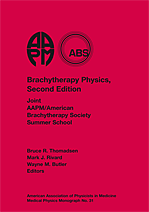
#31 Brachytherapy Physics, Second Edition
Author: Bruce Thomadsen, Mark Rivard and Wayne Butler, eds.ISBN: 9781930524248 ISBN10: 1930524242
Published: 2005 | 982 pp. | Hardcover
Price: $ 175.00
Medical Physics | April 2006
This hefty volume is a stand-alone update to the Proceedings of the 1994 Brachytherapy Society Summer School. It contains a comprehensive documentation of the changes that have occurred in the field over the past 10 years, along with detailed discussions of the invariant and historical aspects of brachytherapy. It is a resource that can be used in many ways. It opens with a concise five page overview of brachytherapy as it is currently practiced, with a clear writing style that is eminently suited for referring doctors, inquisitive patients, or as an introduction for new residents. It covers the basic characteristics and rationale for currently used isotopes, the general applicator types, and the choice of dose rates. Chapter 2, on radiobiology, ends with a mathematical treatise on microdosimetry, which will no doubt stop the lay reader cold, but of course is at the core of what we do.
Following the opening discussion of sources and delivery systems, the text covers the evolving areas of source specification parameters, calculation formalisms, target localization, and treatment planning algorithms. The bulk of the remaining chapters are devoted to in-depth discussions of interstitial and intracavity applications in prostate, head and neck, breast, and gynecological cancers, with a farewell nod to vascular brachytherapy.
It is not likely that one would read the book from front to back, given its length and depth, but it is fascinating to flip through at random, much like many of us did with our parents' multivolume encyclopedia sets as children. Doing so reveals new insights at almost every turn, and an appreciation for the care taken by the 46 contributing authors to present exhaustive reviews of their individual specialties.
The other approach is to use the resource to more fully understand those procedures we are responsible for planning and executing in the clinic. It is here that this book shines. Although not indexed, it is easy to find the latest information on virtually any area of brachytherapy I could think of, from the Manchester system to radiofrequency ablation. The contributing author list contains recently published authors in all of these fields, and each chapter in turn contains reference lists chosen by those experts. Having this reference book in your library is therefore akin to having the guidance of an expert in the subject occupying an office down the hall. There is even a detailed chapter on Regulations, Codes, Directives, Notices, etc., with extensive summaries and updates, complete with internet and e-mail addresses for access to the full reports.
For those with an aversion to 5+ pound books, the publisher has kindly included a CD version, which contains a pdf file of each chapter (titled only by chapter number and first author). It has a separate compiled reference list, in addition to the reference lists at the end of each chapter, but no index or table of contents. The CD is, therefore, not a replacement for the book, but would provide a convenient educational interlude for those long delays between cases when you are stuck in the OR with only your treatment planning laptop. Perhaps the most valuable use of the CD, especially for teachers, is that the pdf format allows you to print any pages you need, in exactly the same format and size as seen in the book.
This publication, like our field, is all about change, and a decade after the 1994 proceedings it is a very valuable tool for the clinical physicist to use in tracking those changes. The reader will also appreciate the great care that was taken in the production of this reference book, by both the authors and the editors.
Reviewed by Larry Beach, Ph.D.
Larry Beach, Ph.D., is senior medical physicist at the Lexington Clinic in Lexington, Kentucky.
